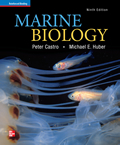1 A) It contains hydrogen and oxygen units B) It is a polar molecule C) A substance with a high specific hear D) All of the above 2 A) Water molecules pack together. B) Bonds form between hydrogen atoms in different water molecules. C) Water molecules move more slowly. D) Water molecules break free of hydrogen bonds. 3 A) At 4°C. B) At 3°C. C) In ice. D) When it freezes. 4 A) True B) False 5 A) The amount of dissolved salts is not the same. B) The water is too hot. C) The oxygen concentration is too low. D) The ratio of ions in the total salinity is different from that in seawater. 6 A) A fish with a swim bladder B) A seal C) A whale D) A deep-sea shrimp 7 A) XBTs B) CTDs C) Bottles with thermometers that "freeze" D) Satellite data 8 A) Sodium B) Calcium C) Chloride D) Fluoride 9 gyres , are caused mainly by the trade winds and westerlies moving the ocean water at an angle due to the Coriolis effect.A) True B) False 10 A) California lies farther north than most states of the U.S.A. and thus is colder. B) The current in the area runs from north to south originating off of Alaska. C) Eastern sides of oceans generally are warmer than western sides. D) The Coriolis effect deflects currents to the left in the northern hemisphere. 11 A) True B) False 12 Trade winds in the Northern Hemisphere result from air sinking at about 30° N latitude, traveling back toward the equator, and moving from east towards the west relative to the ground due to the Coriolis effect.A) True B) False 13 A) True B) False 14 A) True B) False 15 A) the Southern Oscillation B) Downwelling C) La Nina D) Intermediate layer convergence 16 A) Is at 1,500 m or deeper. B) Separates the mixed layer from the deep layer. C) Is a result of solar heating. D) May not exist. 17 A) Unlike the Arctic Ocean, the Southern Ocean has a land mass within it. B) The weather is the worst on Earth in Antarctica. C) Waves in the Southern Ocean can go around the world, and thus have the longest fetch. D) Cold seas have bigger waves than warm ones. 18 A) Because the bottom of the wave motions begins to drag along the bottom as it approaches the shore. B) Wind velocities are always highest near shorelines. C) Water is pushed up the continental slope from great depths. D) Tidal forces act on the oceans only near the coastlines. 19 A) When the sun and moon are at right angles to the Earth during the first quarter and last quarter moon phases. B) When the moon comes closest to the Earth. C) Only in the spring near the Vernal Equinox. D) When the sun, moon and the Earth are in line during a full or new moon. 20 A) True B) False 21 A) True B) False 22 A) An earthquake in the Pacific Ocean. B) Water receding out to sea, exposing reefs and leaving fish out of the water. C) High waves in the open sea. D) Very short wave lengths of incoming surf. 23 A) the Pacific B) the Atlantic C) the Arctic D) the Southern Ocean 24 A) They move counter-clockwise in the Northern Hemisphere. B) They move clockwise in the Southern Hemisphere. C) They move clockwise in the Northern Hemisphere. D) They go directly north in the Northern Hemisphere and directly south in the Southern Hemisphere due to convection.





